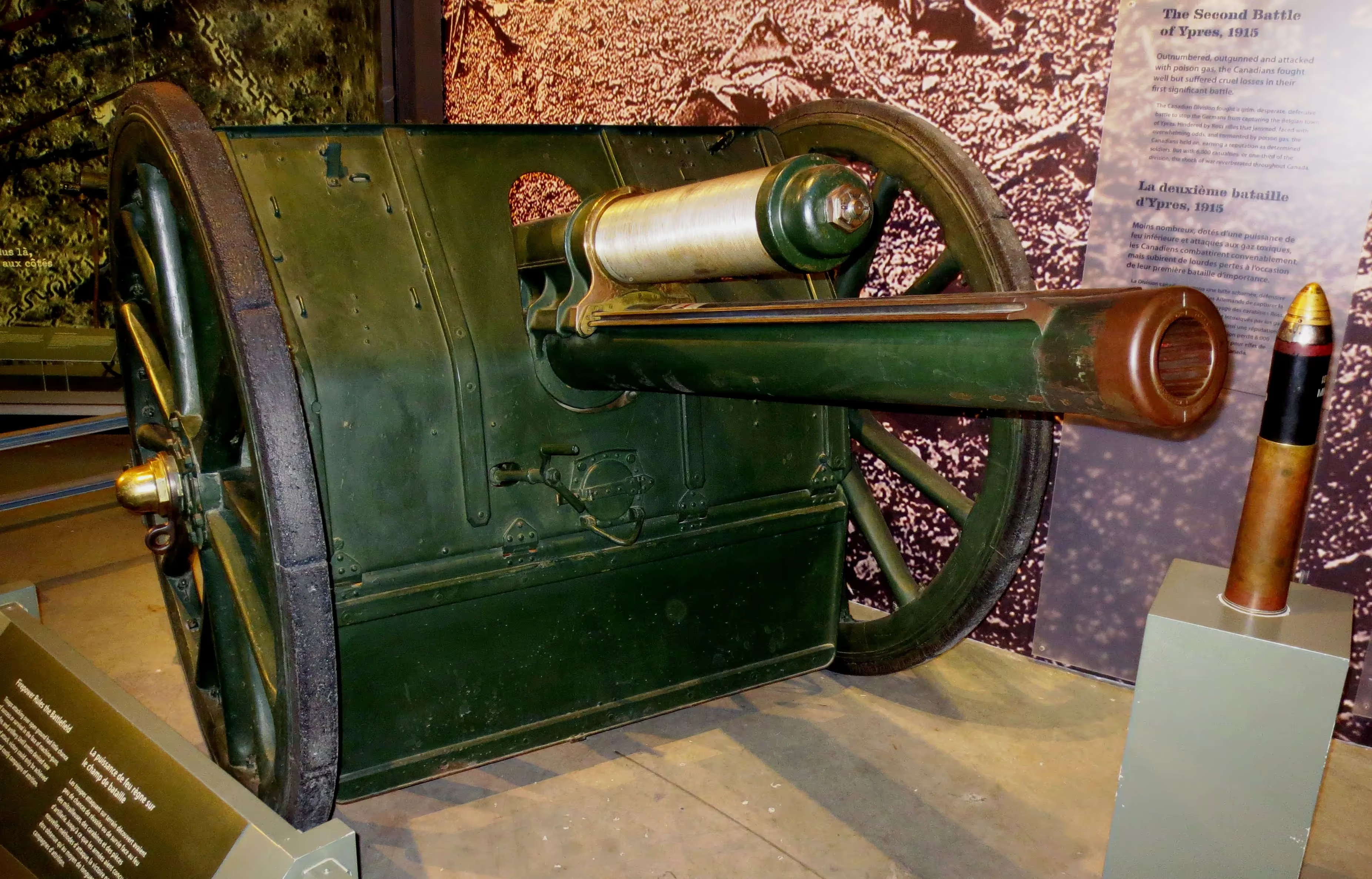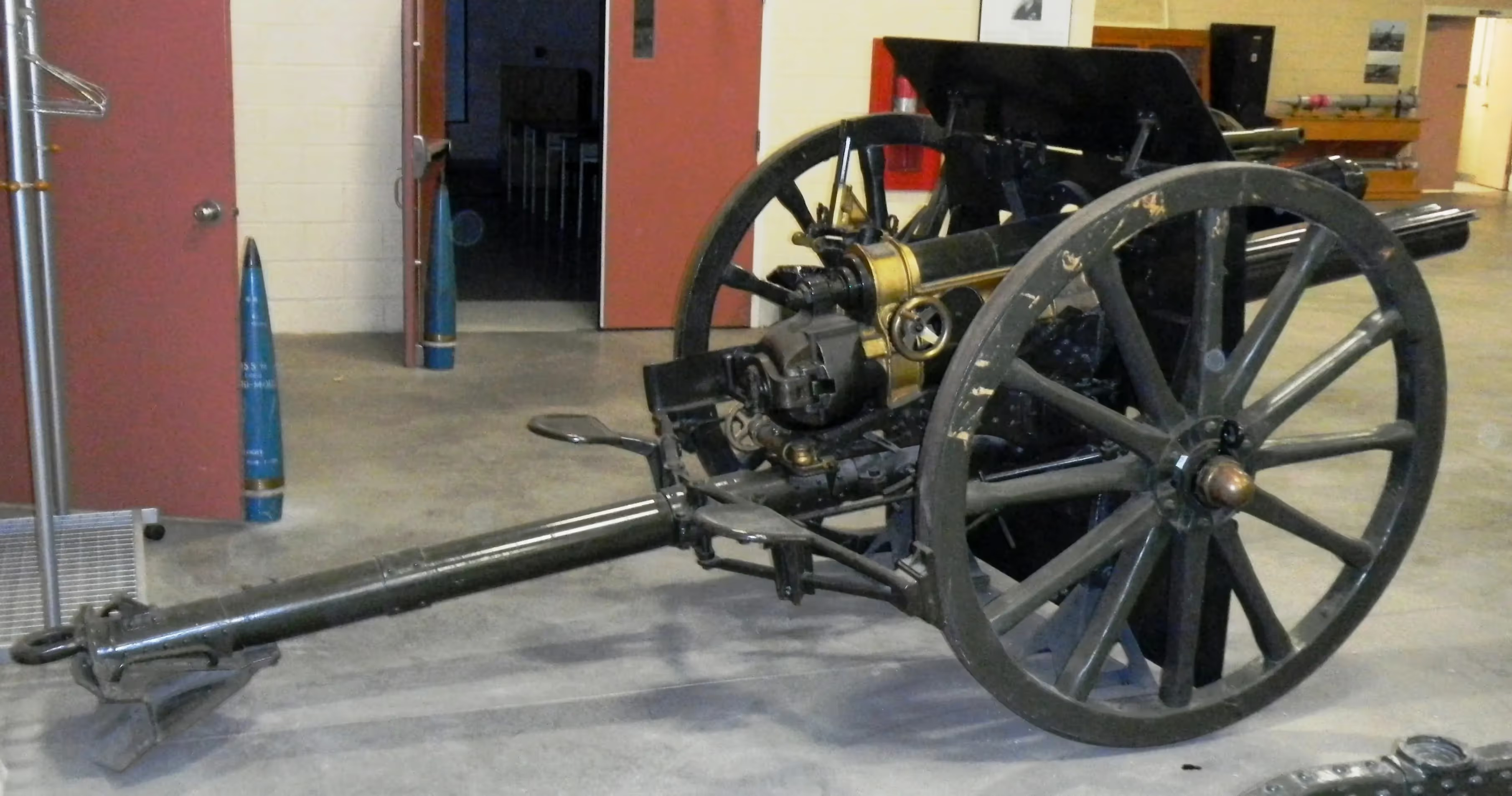Artillery in Canada: 18-pounder QF field gun

(Library and Archives Canada Photo, MIKAN No. 3194248)
Canadian 18-pounder QF Mk. I Field Gun emplacement in France, September 1917.
The Ordnance QF 18-pounder, gun, was the standard British Empire field gun of the First World War-era. It formed the backbone of the Royal Field Artillery during the war, and was produced in large numbers. It was used by British and Canadian Forces in all the main theatres, and by British and Canadian troops in Russia in 1919. Its calibre (84 mm) and shell weight were greater than those of the equivalent field guns in French (75 mm) and German (77 mm) service. It was generally horse drawn until mechanization in the 1930s.
The first versions were introduced in 1904. Later versions remained in service with British forces until early 1942. During the interwar period, the 18-pounder was developed into the early versions of the equally famous Ordnance QF 25-pounder, which would form the basis of the British Canadian artillery forces during and after the Second World War in much the same fashion as the 18-pounder had during the First. (Wikipedia)
* For more detailed data on the QF 18-pounder field gun in Canadian service, Doug Knight's book can be reviewed free on the net here: https://archive.org/details/the-18-pounder-field-gun-in-canadian-service.

(Library and Archives Canada Photo, MIKAN No. 3403462)
Soldiers of the 9th Field Battery, RCA, with an 18-pounder QF Mk. I Field Gun in front of the Armouries in Toronto, Ontario, 15 August 1914.

18-pounder QF Mk. I Field Gun, Camp Valcartier, ca. 1914. (Library and Archives Canada Photo, MIKAN No. 3336980)

(City of Vancouver Archives Photo, AM1535-: CVA 99-597)
18-pounder QF Mk. I Field Gun, 65th CFA, Vancouver, British Columbia, ca 1917.

(Library & Archives Canada Photo, MIKAN 3405482)
18-pounder QF Mk. I Field Gun, ca. 1918.
After the Armistice in 1918, some British and Canadian 18-pounders, including a battery transported portee, were in the British Army of the Rhine in the Rhineland. It also served with British and Canadian forces in North Russia in 1918–1919 and with the Canadian Siberian Expeditionary Force.








(Author Photos)
18-pounder QF Mk. II Field Gun. The gun is inscribed above the breech with its weight 9-0-0 (1,008 lbs), QF 18 Pr Mk II, B.S. Co., crown over P, 1916, No. 5452 (crossed out), ANHI. It is mounted on a wheeled carriage, 18-pounder QF Mk. 1, OCMC, VSM 1905, Reg. No. (blank) on the carriage, No. 35, VS&M, I over 1906, Reg. No. 6431, D of C on left side of the trail. This Field Gun is one of the original 36 guns from the 1903 order. It stands facing the Halifax Citadel.



(Doug Knight Photos)




(Author Photos)
18-pounder QF Mk. II Field Gun, weight 9-0-0 (1,008 lbs), (Serial No. 3820), 1915, mounted on carriage OCM C136.

(Library and Archives Canada Photo, MIKAN No. 3395092)
18-pounder QF Mk. II Field Gun being trialed against enemy tanks, ca 1918.

(Library and Archives Canada Photo, MIKAN No. 3395977)
18-pounders, Ottawa, ca 1920s.
(Author Photos)




(Doug Knight Photos)
.avif)
.avif)
(Author Photos)
18-pounder QF Mk. I (L) Field Gun, EOC 1915, Reg. No. C42073, on loan from Mons, Belgium to Canada for five years, presented on 13 Mar 2018, in honour of the 100th anniversary of the First World War. (Since Mons expect it to be returned, the CWM saved the shipping crate). The 18-pounder belonged to the 39th Battery, Canadian Field Artillery, and first went into action in 1916, participating in a series of battles in the First World War including the Somme, Vimy Ridge and Passchendaele, culminating in the “Hundred Days” offensive between August and November 1918 that won the war. It fired the last Canadian shell on the Western front on 11 Nov 1918, the day the Canadian Corps liberated the southwest Belgian city of Mons, and the four-year war came to an end. On 15 Aug 1919, this Field Gun was presented as a gift from the Canadian military to the city of Mons as a symbol of enduring friendship between the two countries, one forged in tragedy with almost 60,000 Canadian lives lost.
The city of Mons was also where the last Commonwealth soldier, a Canadian, was killed in the war. George Lawrence Price, a 25-year-old from Nova Scotia, was shot by a German sniper two minutes before the Armistice. He is buried in the city’s St Symphorien Military Cemetery. The field gun is called an 18-pounder because it fired an 18-pound shell, filled with explosives, shrapnel, chemicals or smoke. Historians believe the guns fired 100 million shells during the course of the war.
Built in Britain, this piece of artillery also survived the German occupation of Belgium during the Second World War, where older weapons were often captured and repurposed for battle. Canada gave the Mons Memorial Museum an 18-pounder and 4.5-inch howitzer. One of these pieces of artillery is on display in the Museum, with the other in storage.

(Colin Stevens Photo)
18-pounder QF Mk. II Field Gun with limber being towed by a 1936 model Ford-Marmon-Harrington half-track used by the Royal Canadian Artillery, Camp Shilo, 1937.

(Author Photo)
1936 model Ford-Marmon-Harrington half-track. Canadian War Museum, Ottawa, Ontario.






American 75-mm M1917 Field Gun, Bethlehem Steel Coy, 1912, 995 Pounds, (Serial No. 489) on the muzzle. This gun is mounted on a 75-mm Gun Carriage Model of 1917 (British), Bethlehem Steel Company, 1918, (Serial No. 2079), MMC, according to the builder's plate on the carriage. This gun is on loan to the RRCA School at 5 CDSB Gagetown, New Brunswick, from the Royal Canadian Artillery Museum. This is an American version of the British QF 18-pounder modified to fire French 75-mm ammunition. One other gun, an M1917A1, is preserved in the RCA Museum, CFB Shilo, Manitoba.
The U.S. Model 1917 shown here is the original horse drawn type, designated the Model 1917 (or M1917). The one preserved with the RCA Museum at CFB Shilo has been "high-speeded" with Martin Parry gear and therefore is the M1917A1. Although most field artillery enthusiasts note the d muzzle (flush with the front of the recoil guides) of the American piece vis-à-vis its British counterpart, many miss the difference in the configuration of the splinter shield. The main shield (ignoring the top and bottom extensions) of the British gun (both 18-pounder and 13-pounder) is bent back at the level of the gun, whereas the main shield of the American gun is not, but is straight up and down (though tilted back a little from bottom to top). Finally, in the CFB Shilo gun’s description, mention is made of the Bethlehem Steel “Coy”. An American business firm or the American military unit whose size lies between the platoon and the battalion is ALWAYS abbreviated “Co.” NEVER “Coy.” The latter is for British and Commonwealth usage and should be corrected wherever American firms appear. (Nelson Lowry)

(Library and Archives Canada Photo, MIKAN No. 3563835)
Ordnance QF 18-pounder Field Gun, being manned by gunners of the 4th Field Regiment, Royal Canadian Artillery (RCA), during a visit by the Earl of Athlone, Governor General of Canada, to Petawawa, Ontario in 1940.

(Leon Jensen Photo)

(Maxwell J. Toms Photo)



(Terry W. Honour Photos)
18-pounder QF Mk. II VSM Field Gun with pneumatic tires, VSN 1918, Serial No. 8864.


(Clive Prothero-Brooks Photos)
18-pounder QF Mk. I Field Gun with spoked carriage wheels.

(Library and Archives Canada Photo, MIKAN No. 3642847)
18-pounder QF Mk. I Field Guns, Sir Robert Borden, Bramshot, UK, April 1917.

(Library and Archives Canada Photo, MIKAN No. 3395408)
Eighteen-pounder gun mounted on snow sled designed by 68th Battery R.C.A., Northern Russia, ca. February 1919.

(Library and Archives Canada Photo, MIKAN No. 3224682)
75-mm Field Gun mounted front and rear on a Canadian National Railway Armoured train, often traveling through Winnipeg during the Second World War, 15 July 1942.


(Maxwell J. Toms Photos)
U.S. Model 1917A1 (M1971A1) 75-mm field gun (British), Bethlehem Steel Co., 1912, 995 Pounds, (Serial No. TBC) on the muzzle. This gun is mounted on a 75-mm Gun Carriage Model of 1917 (British), Bethlehem Steel Co., 1918, (Serial No. TBC), MMC, according to the builder's plate on the carriage. This gun has been "high-speeded" with Martin Parry gear. It is an American version of the British QF 18-pounder modified to fire French 75-mm ammunition. RCA Museum, CFB Shilo, Manitoba. A similar M1971 field gun is preserved in the Royal Regiment of Canadian Artillery School, 5 Canadian Division Support Group Base Gagetown, New Brunswick.
Although most field artillery enthusiasts note the d muzzle (flush with the front of the recoil guides) of the American piece vis-à-vis its British counterpart, many miss the difference in the configuration of the splinter shield. The main shield (ignoring the top and bottom extensions) of the British gun (both 18-pounder and 13-pounder) is bent back at the level of the gun, whereas the main shield of the American gun is not, but is straight up and down (though tilted back a little from bottom to top). An American business firm or the American military unit whose size lies between the platoon and the battalion is ALWAYS abbreviated “Co.” NEVER “Coy.” The latter is for British and Commonwealth usage. (Nelson Lowry)





